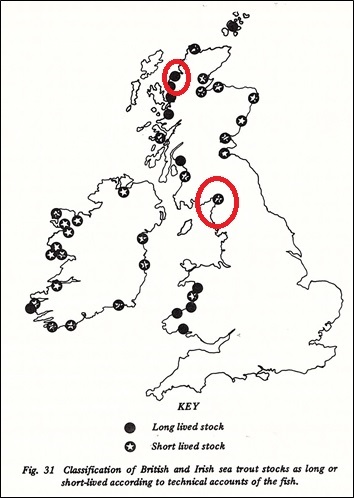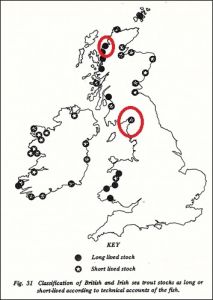So Wrong: In early 2017, the director of Salmon & Trout Conservation Scotland, Andrew Graham Stewart, wrote an article in ‘Trout and Salmon’ magazine titled “Why Dr Jaffa is so wrong”. I recently posted a video addressing the key issue that Mr Graham Stewart raised concerning the lack of large mature sea trout in the west coast Aquaculture Zone. As yet, Mr Graham Stewart has not responded.
By total coincidence, I have just acquired a copy of the out of print book “Child of the Tides – a sea trout handbook” by Irish scientist Edward Fahy, published in 1985 by the Glendale Press. As I scanned the pages, I saw that Dr Fahey had discussed another of the issues mentioned by Mr Graham Stewart; the sea trout of the River Nith. This was because I had previously highlighted that the pattern of wild fish catches from the River Nith was similar to that seen in the Ewe System. I hypothesised that if the decline of sea trout catches in the Ewe system was due to salmon farming then what had caused the similar decline in catches from the River Nith given that the Nith was at least one hundred miles south of the nearest salmon farm.
Mr Graham Stewart wrote that this comparison “is a complete red herring. The Nith in common with the rest of non-salmon farming areas of Scotland has not lost all of its mature sea trout. Furthermore, the Nith hardly bears comparison to the Ewe System; the former meanders through coal-mining and agricultural land whereas the latter runs off barren mountainous terrain”.
At the time, I wasn’t given the opportunity by ‘Trout and Salmon’ magazine to respond to these comments. The obvious response is that Mr Graham Stewart didn’t answer my question. He did not explain why sea trout catches in both the Ewe and the Nith were exhibiting similar declines. Instead, he pointed out that the Nith still produced some larger fish, unlike the Ewe.
In his book, Dr Fahy discusses how different stocks of sea trout vary due to growth and condition. He identifies two different stocks and he says that there is plenty of information in the scientific literature to classify these as Irish and Atlantic stocks (These are necessarily geographic associations). The Irish stocks tend to grow longer in a shorter time than their Atlantic counterparts. In his book, Dr Fahy includes the following table to demonstrate the difference between the two stocks over the first four years of growth.

However, growth is not just about length but also body shape and together these are expressed as the condition factor. Dr Fahy examines condition factor in some detail, which I won’t repeat here, but he concludes that the Irish stock can be expressed as having good condition, whereas the Atlantic stock are generally expressed as having poor condition.
Dr Fahy also investigates the age of these stocks based on the condition factor. His lengthy discussion concludes that stocks are either long or short lived. Generally, the Atlantic stock has more repeat spawners than the Irish stock, although there could be some variation between different parts of the stock.

The question is how does this relate to whether the Nith has larger mature sea trout than the Ewe System and whether this is due to the impact of salmon farming? I believe that the answer can be found in two illustrations from Dr Fahy’s book. The first shows stocks that have been identified as having different condition factors whilst the second highlights long and short-lived stocks (the red circles are mine).
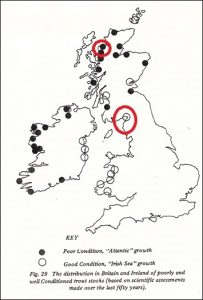
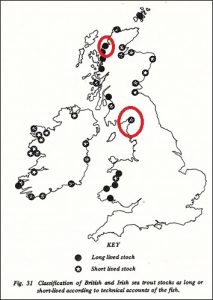
What is apparent from these illustrations is that Ewe System sea trout are of long-lived Atlantic stock that exhibit poor condition, whereas sea trout from the River Nith are short lived Irish stock of good condition. The presence or absence of salmon farms has nothing to do with the makeup of each of these stocks. The River Nith has more larger fish simply because they are from a faster growing stock than the fish in the Ewe System but they tend not to live long enough to become the much larger specimen fish that used to inhabit the Ewe System a hundred years ago.
Of course, none of this addresses the question why sea trout stocks are in decline. I have repeatedly written that sea trout catches along the west coast have being falling since records began in 1952. They are also in decline across a much greater geographic range than just the salmon farming areas. Unfortunately, Mr Graham Stewart is so convinced that salmon farming is to blame that he won’t entertain any other explanation. Sadly, he has spread his narrative throughout the wild fish sector and thus salmon farming is made the sole scapegoat for everything that is wrong with wild salmonid fish.
Mr Graham Stewart also writes that rather than compare the Ewe System with the Nith, I should instead look to the north to Loch Dionard, which he says discharges into the salmon farm free Kyle of Durness as this is now probably the finest small sea trout fishery in Scotland with fish up to 9lb. He says I should compare Loch Dionard with other formerly great sea trout lochs such as Loch Stack and Loch Maree which drain into sea lochs with salmon farms where mature sea trout have been absent for decades. The following graph is taken from the Fisheries Management Scotland Annual Review for 2020. Sea trout catches are shown by the grey line. Catches appear to be of mixed fortune.
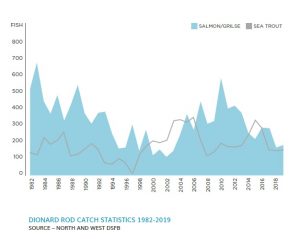
Loch Dionard is part of the Grudie Fishery District. This covers a small area in the north west corner of Scotland. Sea trout catches from the fishery district show in parts both similar and different patterns to those from the Dionard.
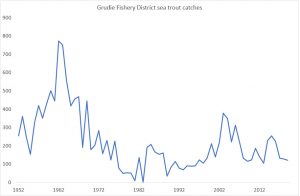
Whilst Mr Graham Stewart says that fish have been caught from the Dionard weighing up to 9lb yet in 2015, a sea trout of 8lb was caught from the Laxford where there has been a salmon farm in production since the 1980s. Mr Graham Stewart also wrote that the Dionard should be compared with the formerly great sea trout fishery at Loch Stack which drains into a sea loch with salmon farming.
I have included the following graph is previous commentaries about the demise of sea trout fisheries. The graph comes from a paper presented at a conference in 1987 and shows that Loch Stack collapsed long before salmon farming became widespread across the north west coast.
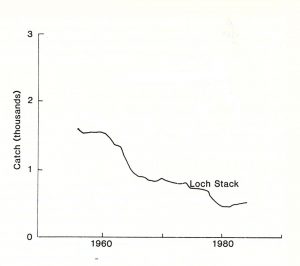
It is also worth mentioning the that the Kyle of Durness is one of the sites sampled for sea lice by the West Sutherland Fisheries Trust. Up to 2015, the data was part of the national RAFTS monitoring programme. The data from 2016 is published on the fishery trust website. What should be noted is that from 2016 to 2019, the percentage of sea trout carrying salmon lice for each year was:
2016: 23-100%
2017: 56-100%
2018: 34-100%
2019: 43%
Although Mr Graham Stewart implies that the area should be lice free because there are no farms in the sea near the river mouth, the reality is that sampled young sea trout are carrying lice and in more than a few instances, every fish sampled has some form of infestation. Clearly, salmon farms cannot be the cause.
Finally, the real crunch is that whilst Loch Maree and Loch Stack are not far in distance from Loch Dionard, the graph from Edward Fahy’s book shows that they are of different stocks with Loch Maree fish coming from a long-lived stock whilst Loch Dionard fish appear to be short-lived.
Mr Graham Stewart argues that Loch Dionard and the nearby Loch Hope are still decent sea trout fisheries because the fish swim out into the open sea and do not have to migrate their way past salmon farms. A more likely explanation for the difference between the fisheries is that the sea trout are from a completely separate stock to those from around Loch Ewe.
The explanation of what is happening to sea trout along Scotland’s north-west coast is clearly not as simple as Mr Graham Stewart would suggest. I would like to extend an invitation to Mr Graham Stewart to respond by writing a guest column for reLAKSation which I would include unedited. Three years ago, Mr Graham Stewart wrote why I was wrong. I would be interested to hear if he still thinks if this is so and why. I look forward to hearing from him and sharing his comments.
Wye?: I came across a tweet this week which referenced an article in the Guardian newspaper by environmental writer George Monbiot. He has been on holiday in Wales and has been disturbed to find that many of the local rivers are dying before his eyes. He says that four years ago he saw the Monnow, a tributary of the River Wye and it had a clean stony bed. This year he said that the bottom is smothered in slime and filamentous algae and rotting weed floats to the surface emitting a stench of cow slurry. Mr Monbiot says that this is increasingly typical of many rivers in the same part of Wales, but it is also commonplace across much of Britain. In 2016, the Government revealed that only 14% of England’s rivers were in good ecological condition. The publication of the next report has been repeatedly delayed.
The author of the Tweet that drew attention to the Guardian article asks why Salmon & Trout Conservation is not actively working hard to demand that many British rivers should urgently be cleaned up but directing much of its time and resources towards its crusade against the salmon farming industry. The tweet highlights the annual report of S&TC trustees and their financial statement for the year up to the end of December 2019.
The report includes a long list of their achievements and performance for 2019 and not surprisingly, the first and largest section relates to salmon farming. It seems that their main activity has been to keep a watching brief on the activities of the Salmon Interactions Working Group, which they say failed to issue its final report by the end of 2019. In fact, it was published this year, to much criticism from S&TC. As I’ve suggested previously, S&TC should join other wild fish interests to form a single voice. If they weren’t willing to be associated to the Working Group, then they have little reason to complain that the recommendations were not as they would have wished.
Other than watch SIWG, S&TC have issued some press releases and have been interviewed a handful of times by the mainstream media but that’s about it. In total, it seems that S&TC have spent about £83,000 on activities aimed against salmon farming (£127,000 last year).
For 2020, S&TC have outlined what they hope to achieve in their continued battle against the salmon farming industry. I know what I would like them to achieve and it shouldn’t cost them anything and that is to start to answer some of the questions that they seemingly refuse to answer. In my opinion, the salmon industry is only going to respond to S&TC’s demands if they understand the rationale and the science behind them and at present, I for one am still waiting for yet unanswered explanations.
What else the annual report, dated June 1st reveals, is S&TC’s policy regarding the Missing Salmon Alliance:
“We have been cooperating with the Atlantic Salmon Trust, Game & Wildlife Conservation Trust and Angling Trust in a coalition under the title, The Missing Salmon Alliance, to coordinate research, data collection and political influencing required to reverse the decline in UK salmon stocks. The Alliance was launched at a seminar in November 2019 and is in the process of employing a small data-collection team to bring together evidence of where salmon are being lost across their North Atlantic range. S&TC’s present contribution to the Alliance is through our salmon farming reform and water quality work.”
Clearly, that co-operation did not last long!
C&R Mortality: I came across another tweet from Eva Thorstad, one of the joint leaders of the Expert Committee on Salmon Management and a fish scientist working at the Norwegian Institute for Nature Research. Regular readers may also remember that Dr Thorstad was one of the two authors of the report about the impacts of salmon farming on wild fish that was commissioned by Salmon & Trout Conservation. I mention this as illustration that her work is respected by the Scottish angling sector.
Dr Thorstad’s tweet referred to a newly published paper of which she is a co-author. The paper comes from Canada and is titled ‘Mortality of Atlantic Salmon after catch and release angling; assessment of a recreational Atlantic salmon fishery in a changing climate. Unfortunately, the paper is not open access, but Dr Thorstad summarises it by saying that catch and release mortality is generally low when rivers are cooler. She says that at temperatures less that 12oc, the mortality is less than 5% but when temperatures rise, so does the mortality of fish returned after being caught. The average mortality is 16% at 18-20oc with an upper figure of 33%.
A paper published in 2018 looked the work of the James Hutton Institute and Scotland’s Rural College in which they plotted maximum water temperature from beat D of the River Spey and found that there is strong statistical evidence that the river is warming. Their graph shows that there have been many incidences where the river has exceeded the 18oC temperature and therefore risking higher mortality on returned fish.
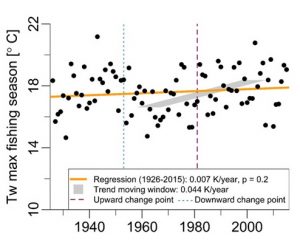
In 2018, the BBC reported that the temperature in the River Gairn, a tributary of the River Dee, reached 27.5oc. They say that the fish will die if the temperature reaches 30oc and remains at that temperature for several days. The Canadian paper say that repeated high temperatures have led to fishery closures. Perhaps in Scotland, it is not enough just to plant trees in the hope of keeping river temperatures from rising too high.
Travis E. Van Leeuwen, et al. Can. J. Fish. Aquat. Sci. 00: 1–11 (0000) dx.doi.org/10.1139/cjfas-2019-0400

